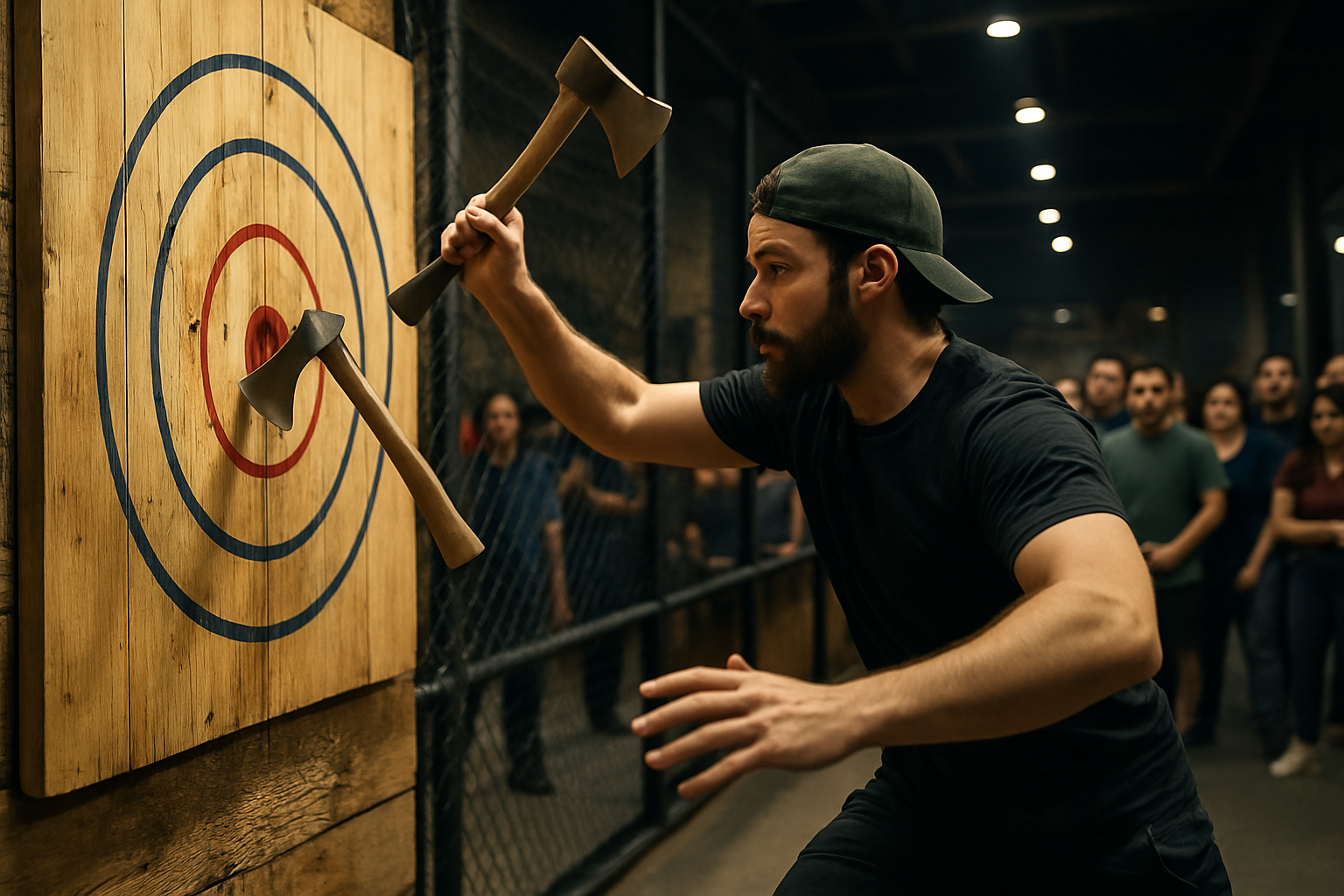Competitive Axe Throwing: From Lumberjack Roots to Urban Sport Sensation
Imagine the satisfying thud of a sharpened axe embedding itself into a wooden target, followed by raucous cheers from a crowd of enthusiastic spectators. This isn't a scene from a medieval battlefield or a remote logging camp – it's the heart-pounding excitement of competitive axe throwing, a sport that's rapidly gaining popularity in urban centers across the globe. Once relegated to lumberjack competitions and forestry demonstrations, axe throwing has emerged as a thrilling recreational activity and competitive sport that combines skill, precision, and a dash of danger.

These early competitions, often held at county fairs and logging camps, included events like tree climbing, log rolling, and of course, axe throwing. Participants would compete to see who could throw their axe with the greatest accuracy, often aiming at painted targets on tree stumps. These events were not only a way to demonstrate prowess but also served as a form of entertainment for isolated logging communities.
As urbanization increased and the logging industry modernized, these traditional skills began to fade from everyday life. However, the spirit of competition and the thrill of axe throwing persisted, setting the stage for its modern revival.
The Modern Resurgence of Axe Throwing
The contemporary axe throwing movement can be traced back to 2006 in Toronto, Canada. Matt Wilson, a bartender and backyard enthusiast, began organizing axe throwing events for friends. What started as a casual backyard activity quickly gained traction, leading Wilson to establish the Backyard Axe Throwing League (BATL) in 2011.
BATL’s success sparked a wave of interest, and soon axe throwing venues began popping up across Canada and the United States. The sport’s appeal lies in its unique combination of skill, competition, and social interaction. Unlike traditional bar games like darts or pool, axe throwing offers a more visceral and primal experience that resonates with urban dwellers seeking novel forms of entertainment.
As the sport grew, so did the need for standardization and organization. In 2016, the World Axe Throwing League (WATL) was formed to establish uniform rules and promote the sport globally. Today, WATL oversees hundreds of affiliated venues across more than 20 countries, hosting regional and international competitions.
The Mechanics of Competitive Axe Throwing
At its core, axe throwing is deceptively simple: participants throw an axe at a wooden target, aiming to hit the bullseye. However, mastering the technique requires a combination of strength, finesse, and consistent practice.
The standard competitive format involves throwing an axe from a distance of 12 to 15 feet at a target consisting of five concentric rings. The outermost ring is worth one point, with point values increasing towards the center. The bullseye, or “killshot,” is worth six points. Matches typically consist of 10 throws, with the highest score winning.
The throwing technique itself is crucial. Most throwers use a two-handed overhead throw, gripping the axe at the bottom of the handle. The thrower steps forward, brings the axe back over their head, and releases it with a smooth, fluid motion. The axe should ideally complete one full rotation before striking the target.
Various axe designs are used in competition, but the most common is the “throwing axe,” weighing between 1.5 to 2.5 pounds with a 14 to 19-inch handle. The blade must be between 3 and 4.75 inches wide. These specifications ensure consistency and fairness across competitions.
Safety and Regulation in Axe Throwing
While the idea of hurling sharp objects for sport may seem inherently dangerous, competitive axe throwing has an impressive safety record. This is largely due to strict regulations and safety protocols implemented by governing bodies and individual venues.
WATL and other organizations have established comprehensive safety guidelines that all affiliated venues must follow. These include:
-
Designated throwing areas with clear barriers between lanes
-
Trained axe throwing coaches who supervise all activities
-
Mandatory safety briefings for all participants
-
Proper maintenance and inspection of axes and targets
-
Age restrictions (typically 18+ for competitive throwing)
-
Prohibition of alcohol consumption before or during throwing
Additionally, axe throwing venues are designed with safety in mind. Throwing lanes are enclosed on three sides, with chain link fences or wooden barriers separating adjacent lanes. Spectator areas are positioned well behind the throwing line, ensuring that errant throws pose no risk to onlookers.
The controlled environment and emphasis on safety have contributed significantly to the sport’s growth, making it accessible to a wide range of participants regardless of age or athletic background.
The Cultural Impact of Axe Throwing
As axe throwing has transitioned from a niche activity to a mainstream sport, its cultural impact has been significant. The sport has tapped into a desire for unique, experiential activities, particularly among millennials and urban professionals seeking alternatives to traditional entertainment options.
Axe throwing venues have become popular destinations for corporate team-building events, birthday parties, and even date nights. The sport’s appeal lies in its ability to provide an adrenaline rush and sense of accomplishment in a controlled, social setting. It offers a temporary escape from the digital world, allowing participants to engage in a physical activity that connects them to more primal instincts.
The rise of axe throwing has also sparked interest in related activities and skills. Many enthusiasts have begun exploring traditional woodcraft, bushcraft, and other outdoor skills. This has led to a resurgence of interest in traditional tools and techniques, with some axe throwers even forging their own axes or sourcing artisanal, hand-crafted throwing axes.
Furthermore, the sport has created new economic opportunities. Axe throwing venues have become anchor tenants in revitalized urban areas, often occupying former industrial spaces. The industry has created jobs for coaches, venue managers, and axe makers, contributing to local economies and urban renewal efforts.
Competitive Landscape and Professional Opportunities
As axe throwing has grown in popularity, a competitive ecosystem has emerged, offering opportunities for skilled throwers to showcase their talents and even pursue professional careers.
WATL organizes a series of regional and national competitions culminating in the World Axe Throwing Championship. This annual event, broadcast on major sports networks, offers substantial prize money and has helped elevate top throwers to minor celebrity status within the community.
Other organizations, such as the International Axe Throwing Federation (IATF) and the National Axe Throwing Federation (NATF), also host competitions and leagues, providing multiple avenues for competitive throwers.
Professional opportunities in axe throwing extend beyond competition. Skilled throwers can find work as coaches, demonstrators at events, or even performers in traveling shows. Some have leveraged their expertise to launch YouTube channels, podcasts, or instructional businesses, capitalizing on the growing interest in the sport.
The competitive aspect of axe throwing has also driven innovation in technique and equipment. Top throwers are constantly refining their methods, experimenting with different grips, stances, and release points to gain an edge. This has led to the development of specialized training programs and analytics tools, mirroring trends seen in more established sports.
Axe Throwing and Gender Equality
One of the most notable aspects of competitive axe throwing is its commitment to gender equality. Unlike many traditional sports that separate men and women into different leagues or weight classes, axe throwing competitions are typically open to all genders competing on an equal footing.
This inclusivity has been a cornerstone of the sport’s ethos from its early days. The physics of axe throwing – relying more on technique and precision than raw strength – creates a level playing field that allows men and women to compete directly against each other.
The sport’s top ranks include numerous female champions who have achieved success in mixed-gender competitions. This has not only challenged gender stereotypes but has also made axe throwing particularly appealing to women seeking a sport where they can compete on equal terms.
The inclusive nature of axe throwing extends beyond gender, embracing participants of various ages, body types, and athletic backgrounds. This diversity has contributed to the sport’s welcoming community atmosphere and has been a key factor in its rapid growth and widespread appeal.
Environmental Considerations and Sustainability
As axe throwing has grown from a backyard pastime to a global sport, questions of environmental impact and sustainability have come to the forefront. The sport’s reliance on wooden targets and handles raises concerns about resource consumption and waste.
Many axe throwing venues and organizations have taken proactive steps to address these issues:
-
Sustainable sourcing: Using wood from certified sustainable forests or reclaimed timber for targets and handles.
-
Recycling programs: Implementing systems to recycle worn-out targets and axes, often repurposing them into smaller targets or other wood products.
-
Local partnerships: Collaborating with local woodworkers and artisans to create axes and targets, reducing transportation emissions and supporting local economies.
-
Education initiatives: Using the sport as a platform to educate participants about forest conservation and sustainable resource management.
Some venues have experimented with alternative materials for targets, such as high-density foam or synthetic composites, which offer longer lifespans and reduced environmental impact. However, these alternatives have faced resistance from purists who argue that they alter the fundamental experience of the sport.
The axe throwing community’s engagement with environmental issues reflects a broader trend in sports towards sustainability and ecological responsibility. As the sport continues to grow, finding a balance between tradition and environmental stewardship will be crucial for its long-term viability.
The Future of Axe Throwing
As competitive axe throwing enters its second decade as an organized sport, its future appears bright but not without challenges. The sport’s rapid growth has shown no signs of slowing, with new venues opening regularly across North America, Europe, and increasingly, Asia and Australia.
Several key trends are likely to shape the sport’s evolution:
-
Technological integration: The introduction of electronic scoring systems, slow-motion replay for judges, and mobile apps for tracking performance and organizing leagues.
-
Diversification of formats: Development of new game modes and target designs to keep the sport fresh and appealing to a broad audience.
-
Youth development: Creation of junior leagues and school programs to introduce axe throwing to younger generations, ensuring a pipeline of future talent.
-
International expansion: Efforts to grow the sport in new markets, particularly in countries with strong timber sports traditions.
-
Olympic aspirations: While still a long shot, there are ongoing discussions about the potential for axe throwing to be included as a demonstration sport in future Olympic Games.
However, the sport also faces challenges. As it grows, maintaining the grassroots, community-driven spirit that has been central to its appeal will be crucial. There’s also the ongoing need to balance commercialization with authenticity, ensuring that the sport remains true to its roots while embracing new opportunities for growth and exposure.
Safety will continue to be a paramount concern, particularly as the sport attracts more casual participants. Maintaining the excellent safety record will be essential for the sport’s reputation and continued expansion.
Conclusion
Competitive axe throwing’s journey from lumberjack pastime to urban sport sensation is a testament to its unique appeal and the power of community-driven initiatives. By combining primal skills with modern organization and safety standards, axe throwing has carved out a niche in the sporting world that resonates with a diverse audience.
The sport’s emphasis on inclusivity, its blend of individual skill and social interaction, and its connection to traditional crafts have all contributed to its rapid growth and cultural impact. As it continues to evolve, axe throwing stands as a fascinating example of how ancient skills can find new relevance in the modern world.
Whether as a competitive pursuit or a casual social activity, axe throwing offers a unique blend of challenge, excitement, and camaraderie. As the thud of axes hitting targets echoes through urban venues worldwide, it’s clear that this once-niche activity has firmly established itself as a sport with a bright and dynamic future.




